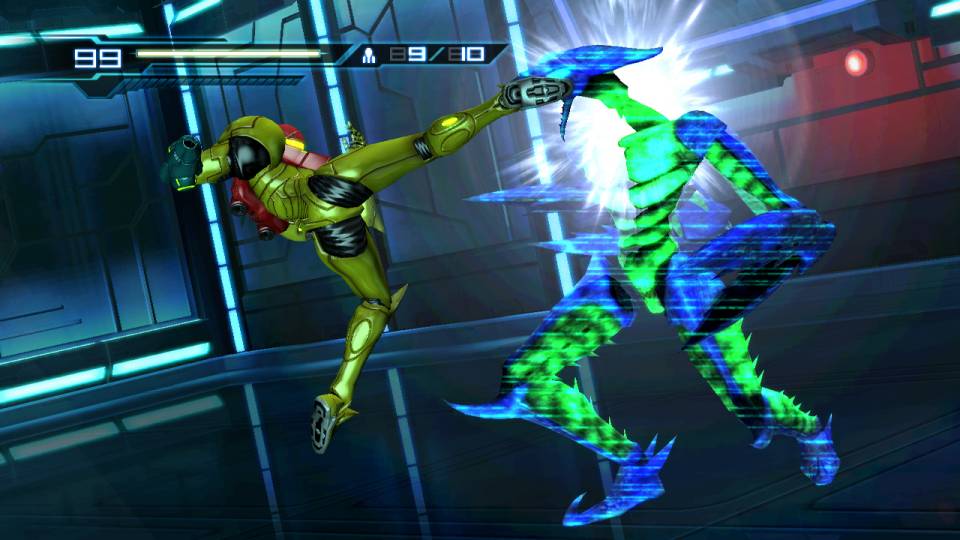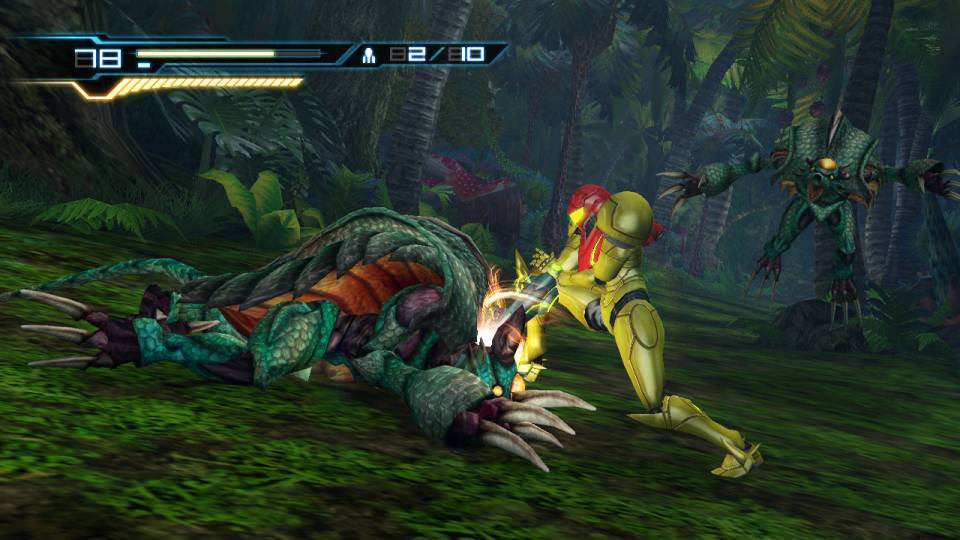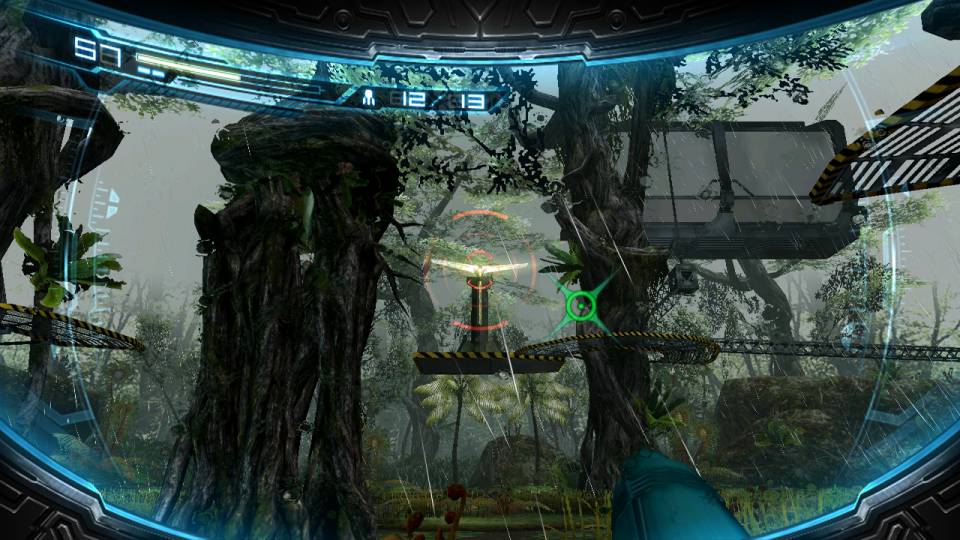All I've really wanted out of Metroid since the Prime series ended is, well, another Metroid. Outside of this specific context, I'm talking about what a lot of people refer to as "Metroidvania," but since we're planted squarely in the franchise that started the whole thing, let's just call it a new Metroid game.

I wouldn't really have cared if it were on the Wii or the DS (or heck, even DSiWare--Lord knows that service could use a top-tier franchise game). I just want to collect energy tanks and an ice beam and backtrack a lot, in 2D. Metroid: Other M is not exactly that (or not entirely that) sort of game. Before I got to play a more or less finished build earlier this week, I wasn't sure what kind of game it was, but now I've got a pretty good handle on what to expect from Nintendo's next big franchise title when it ships at the end of the month.
While there are plenty of signature Metroid touches in here, I was surprised at how much Team Ninja's influence seems to be evident in the game's design, too. If you haven't seen much of it in action, Other M feels a bit like a character action game--think God of War or, yeah, Ninja Gaiden. You move Samus around in 3D spaces without any manual camera control--instead the camera angle is determined by where you are in the environment--fighting and avoiding enemies with a bunch of flashy action moves, only one of which is "shooting."

You mostly play Other M with the Wii remote sideways, like an NES controller, though I have to admit that moving Samus around in 3D with only the 8-way d-pad felt a little odd. An analog stick would probably have been more appropriate here, but then Other M also relies on enough aspects of the Wii remote that the classic controller wouldn't really cut it. When you're in third-person mode, Samus auto-aims at whichever enemy you're most directly facing, but you can go to a first-person mode by pointing the remote directly at the screen, which gives you more precise aim and lets you lock onto specific enemies with your missiles. You can't move in first-person, though, so you have to make sure you put some distance between you and any threats before you switch perspectives.
In fact, crowd control seems to be a major focus in Other M, since you'll frequently have half a dozen or more weaker monsters coming at you at once. Luckily Samus has a ton of ways to attack and evade all her foes. You can do an automated dodge move by tapping the correct d-pad direction right before an enemy connects with an attack, and you get a little flash of green energy around Samus as she backflips or rolls out of the way, to show that you pulled off the dodge. You've also got an array of fairly un-Metroid-like scripted kill moves. These seem to be enemy-specific--when I used one on a sidehopper, Samus jumped on its back and basically put her arm cannon right up against its head to blow it away. Harsh. These kind of nimble, acrobatic moves looked like they were straight out of Bayonetta or something, but then, it didn't feel inherently out of place for Samus to be doing them instead.

Speaking of sidehoppers, there were a lot of classic enemies in the demo I played, which kicked off about an hour into the game. Samus was investigating an installation that had issued a distress call, and immediately I started running into not just the hoppers but also the sorts of spine-covered wall crawlers and fly-like insectoid enemies that were all over the original NES Metroid. A more devoted fan than I would be able to tell you what all those things are actually called, but if you've played much of the old Metroid games, you'll know them immediately. Most of those enemies can be dealt with in third-person by simply mashing on the auto-aim arm cannon, but since your missiles do splash damage, you can sometimes take out a whole group by quickly dropping to the aiming mode and locking on.
At least in this early part of the game, the flow of Other M felt straightforward and pretty linear, since there was generally only one direction I could go at any given time. I'm hoping the game will open up and focus more on exploration deeper in, but even in this early area, there were at least some classic hidden Metroid items like missile tanks to find. Curiously, the game actually marks the presence of a hidden item on your map screen once you've cleared an area, but it's still up to you to figure out exactly where in the area it's located and how to get to it. Before the demo was over, I was definitely getting that familiar itch to hunt down every missile upgrade and energy tank I could find, and Nintendo reps assured me that there would be plenty of that familiar Metroid style of backtracking when you gain new items to gain better access to old areas. I just hope the game doesn't make it too easy to find all of those hidden items.
The morph ball plays a major role here, of course, since there are a lot of tight spaces you'll need to roll through to get to hidden places. Rolling through tunnels in ball form looks more or less like it did in the Prime games, though I was surprised to see that Samus can grab and hang from ledges in Other M, and then sort of hop up into small spaces by hoisting herself up and transforming into the morph ball as she does so. Of course, it wouldn't be Metroid if you couldn't drop a bomb underneath yourself to bounce upward, as well. The game seems to take most of its morph ball cues from Prime, since the camera will go to a side view for the larger mazes that you have to navigate through, like it did in Retro's games.
The deeper into the base I got, the weirder things started to get. Samus entered some organic-looking outdoor areas with cliff faces, flowing streams, and bright blue skies--areas that turned back into the cold grey metal of the installation once she found control panels that switched off the holograms generating the outdoor illusion. I also got to fight a sort of mini-boss here, a two-legged creature with an obvious weak spot on its chest that charged at me periodically. The solution there, of course, was to dodge out of the way and then pop into first-person to lock onto the weak point before the beast could charge at me again. Later I encountered a much bigger, scripted boss monster while I was climbing up the inside of an elevator shaft. This time, I actually had to make use of some of the machinery inside the shaft to win, but I'll avoid spelling out exactly how I did it in the interest of letting you figure it out for yourself. It's not like the game is very far off at this point.
I'm not one hundred percent sold on Other M's mixture of gameplay styles--I think its ultimate success will depend on how exploration-heavy the later game is, and how demanding and satisfying the combat becomes. But despite this unexpected new direction for the series, it felt enough like Metroid that I'm really looking forward to digging deeper into it when it ships later this month. We'll definitely bring you more media and impressions from Other M as soon as we can.
Gallery




